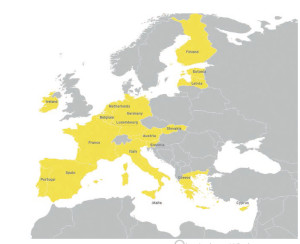
hurdles for MENA corporates doing
business with SEPA countries
JENS MIKOLAJCZAK – co-head of corporate cash management, EMEA, Deutsche Bank – discusses why SEPA matters for non-European corporates, and why 2015 is the year to consider its wider benefits
On August 1 2014, the deadline for implementing obligatory Single Euro Payments Area changes passed for the 32 countries in the SEPA-zone. The culmination of a concept that began with the euro, this deadline saw the ultimate achievement of a standardised and harmonised payments region, homogenising the previously different retail systems, prices, and regulations.
However, this is not just a regulatory or policy change; the European Commission has emphasised that it is part of a bigger picture – the digital agenda. The standardisation – both legal and technical – that SEPA offers will reduce the cost of payments, increase competition and maximise the ease of cross-border payments.
Moving from paper to digital formats, for invoices for example, will lead to significant cost savings across the SEPA-zone. While implementation incurred time and monetary costs, the end-result heralds a new era for Europe.
What may be less apparent is that SEPA also has implications for those corporates outside the eurozone – indeed, its sphere of influence is far wider than the 32 countries directly affected. SEPA is significant for those outside its zone in three separate ways: compliance, imitation and innovation. SEPA may seem like a localised development, but, in fact, multinational corporates cannot afford to ignore its broader implications – nor miss out on the example it sets for payments and treasury.
Achieving compliance
First, corporates outside the SEPA-zone that conduct trade within it, as well as any businesses that transact in euros, must comply with new SEPA regulations and formats by October 2016. This entails technological changes – transitioning to SEPA Credit Transfer (SCT) and SEPA Direct Debit (SDD) standards and the XML ISO format – and inter-departmental alignment.
Although there is still ample time to introduce these changes and any necessary upgrades, as ever with market changes there are significant advantages to being an early mover.
During this period – once compliance has been achieved – treasurers should look into leveraging the necessities of compliance to make additional improvements to treasury processes. The fundamentals of SEPA can be a useful launch-pad for achieving other enhancements to access better transparency, operational efficiency and cost savings.
For example, multinational corporates – from the Middle East to Africa and Asia – with trade or subsidiaries in Europe can simplify their operations by rationalising both the number of bank accounts and treasury departments within the zone.
By reviewing their current structure, corporates can exploit the obligatory changes and upgrades and take further steps to transform a disparate treasury system to one with a higher degree of control and organisation.
Rationalising – and centralising – treasury or banking structures can save on administrative costs, improve liquidity and provide a more granular and up-to-date overview of a corporate’s position. It may also be possible to reduce corporate-to-bank tools, communication links and systems.
While any such moves to centralise and rationalise must be carefully considered (for example, in some cases it may be necessary to retain local accounts for the purposes of transactions such as tax or salary payments) embracing this SEPA-style mindset can unlock significant benefits.
Indeed, corporates – or regions – that aren’t directly affected by SEPA regulations, may, nonetheless, wish to replicate aspects of SEPA to leverage the benefits of standardisation and enhanced communication and efficiency. Multinational corporates should view SEPA as an opportunity for improvement not just within their European operations but globally, by using SEPA formats and standards to extend the potential for rationalisation and centralisation, and support end-to-end automation and working capital and supply chain management advantages.
The global acceptance of the XML format allows it to be extended to other initiatives following in SEPA’s footsteps. XML could be used, for example, for data flows with a foreign exchange element seamlessly integrated. In addition to harmonising formats, SEPA also allows corporates, both within and without the SEPA-zone, to harmonise their IT landscapes in terms of systems – leading to further cost savings.
Finally, either through the utilisation of SEPA formats and processes, or through banks’ extension of best-practice offerings, corporates outside the zone will enjoy access to more sophisticated tools and innovative offerings.
For example, use of Payment-or Collection-On-Behalf-Of (POBO/COBO) structures go hand in hand with streamlining bank account or treasury networks, as do enhanced reconciliation programmes, virtual accounts and financial supply chain management. For example, for the latter, the standardised format used for SEPA means that financing can be bundled alongside payments, integrated on either the confirmed payables or direct debit side of the transaction.
Thanks to SEPA, many corporates will find these tools more accessible because of the significant enhancement to transaction-related data delivery throughout the clearing cycle, ensuring that the granularity of the data – for example relating to the underlying counterparty – is fully transferred without truncation.
As such, intra-group reconciliation can be carried out by one central (physical) bank account across a structure of other, virtual, sub-accounts – in turn enabling the operation of an in-house bank through a Shared Service Centre (SSC). Clearly, the legal and regulatory, tax and market environment must be considered in any area where treasurers are considering rationalising or using Payment Factories or virtual accounts – but the potential is there.
Equally, corporates that use the SEPA XML format will find it simpler to act on preferences for bank-agnostic solutions; the standardised format makes it easier to compare and move between banks. These are popular because of their potential to mitigate risk by decreasing reliance on a specific bank-hosted solution, and can be seamlessly integrated with the rest of the company via the Enterprise Resource Planning System (ERP).
Furthermore, previously localised Additional Optional Services may, driven by the SEPA momentum of extending best practices, be offered on a wider scale throughout the eurozone – and potentially beyond. And as the development of sophisticated solutions such as SSCs and Payment Factories continues in the SEPA-zone, multinational corporates will be better placed to deploy similar structures in other regions.
With a little help
Globally, a clear trend is emerging for treasury practices – the desire for more simplified, visible, automated and efficient structures able to more effectively leverage strong bank offerings.
The treasurer – in and out of the SEPA-zone – is transforming from a cost centre to a value creator, and improvements such as those enabled by SEPA can result in year-on-year savings. With the right bank support from a global and experienced provider, corporates can build on the necessary compliance-driven changes and the greater SEPA blueprint to design a better treasury structure and payments workflow.
Indeed, several corporates from the Middle East, North Africa and Asia have already implemented SEPA workflows for euro payments and are beginning to analyse, review and exploit the further operational benefits of such changes. However, bank knowledge and expertise is crucial to this process – and, for this reason, Deutsche Bank has provided a whitepaper (Beyond SEPA) to help inform the market of the benefits (and challenges) of leveraging the SEPA initiative for enhanced treasury practices.
For corporates outside of the EU that have previously refrained from trading with that region – due to obstacles such as the cumbersome process of collecting – this has now changed.
One of the most significant implications of SEPA is that it has lowered the hurdles for doing business with SEPA countries, with the new toolbox of SEPA standards (such as SDD) making previously unviable trade possible and beneficial due to the lower costs of payments and more streamlined processes.
Directly, SEPA offers a globally accepted format with more granular data, but it is also a catalyst for a host of other advantages – from reducing the number of European bank accounts or subsidiary treasury departments in operation to integrating financial supply chain financing in the payment transaction, and easing the implementation of POBO/COBO structures.
In this new payments era, the time is now right for treasurers to conduct a thorough investigation into the current state of their payment processes and treasury and banking networks across their group, and pinpoint where improvements, upgrades, or changes can most fruitfully be made.
In doing so – and ahead of peers – they will ensure that they are best positioned in the new payments landscape.
SEPA has certainly changed the cashflow landscape in Europe – but these changes will continue to spread deeper and wider as the greater benefits are recognised. n
 Cash And Trade Magazine For Cash and Trade professionals in the Middle East
Cash And Trade Magazine For Cash and Trade professionals in the Middle East





